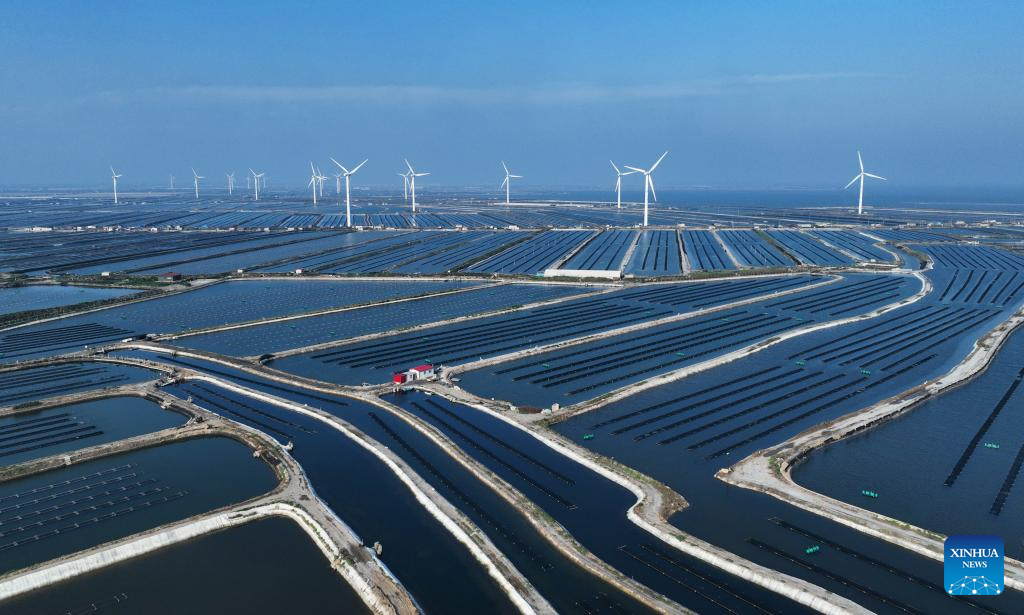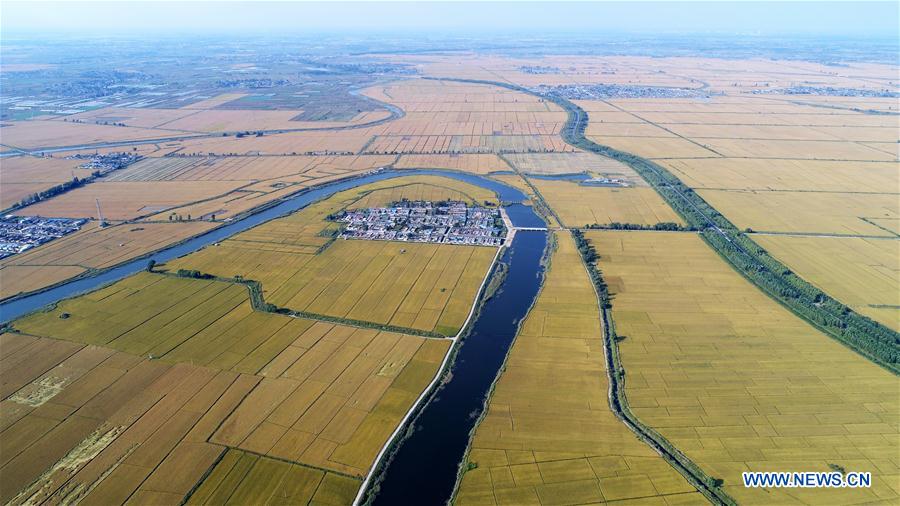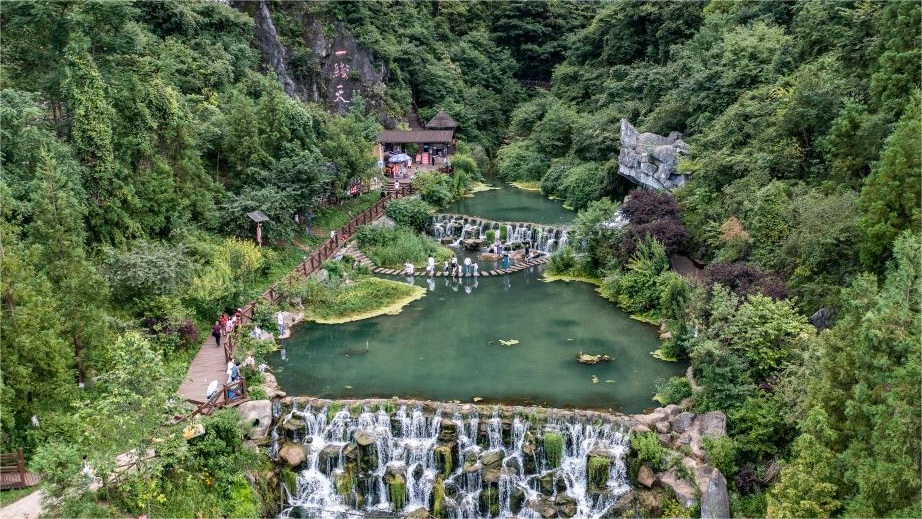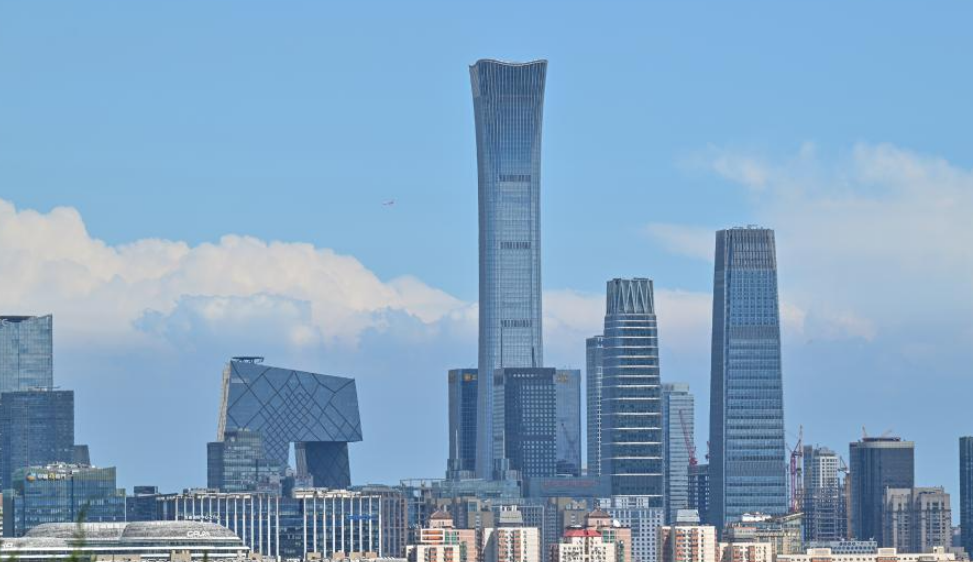N China’s coastal county transforms saline-alkali land into symbiotic grain-seafood farms

This aerial photo taken on July 17, 2023 shows the view of a marine farm in Laoting county, north China's Hebei Province. (Xinhua/Yang Shiyao)
“In the fields, we grow rice as shrimps and crabs hide amongst the rice seedlings,” said Duan Yanyan, a hardware engineer who monitors in real time 8,000 mu (about 533.33 hectares) of rice paddies via a large screen in the control room of an agricultural demonstration zone in north China’s Hebei Province.
The rice paddies, established to efficiently utilize the saline-alkali land in Laoting county, Hebei Province, support the raising of crabs and shrimps. The paddies make up a “smart agricultural” demonstration zone formed in the county.
The smart agriculture management platform displays real-time data on such factors as water level, water quality, weather, pest control, seedling conditions, and soil.
Duan said that the on-site experts discovered that to successfully grow rice while maintaining a healthy environment for crabs and shrimps, the water level should be 8 centimeters.
With the help of sensors installed across the rice paddies, the smart agriculture management platform gives early warning when the water level is below the set level, and the remote-control system allows water pumps in the fields to automatically draw water to replenish the rice paddies, Duan explained.
These seemingly ordinary rice fields are equipped with water pipes underneath, which can meet the fields’ irrigation needs while helping with salt drainage, said Wei Mingzhao, an executive of the demonstration zone.
The water pipes, together with irrigation canals and ditches, have formed an ecological circulation system that facilitates science-based, efficient restoration of soil fertility for saline-alkali land, Wei said.
Crabs, shrimps, and fish seedlings are introduced into the fields as soon as rice transplantation is completed, Wei said, explaining that grass seeds and microorganisms are natural food for crabs, shrimps and fish.
The unit price of the pesticide-free rice from the rice-crab co-culture fields can reach 20 yuan ($2.79) per kilogram, according to Wei.
While promoting rice-crab co-culture and improving soil conditions, the demonstration zone has also introduced saline-alkali tolerant rice varieties to increase the yield of the rice fields.
Compared to common rice varieties, the new saline-alkali tolerant varieties have a significantly higher per-mu yield, which can reach around 700 kilograms, according to Zheng Aimeng, a local farmer who has benefited greatly from the efficient utilization of saline-alkali rice fields.
Zheng has grown 100 mu of saline-alkali tolerant rice this year, which is expected to generate an annual net income of over 40,000 yuan for him. He also earns an annual salary of more than 60,000 yuan by operating agricultural machinery for the demonstration zone.
According to official statistics, the salt content in the saline-alkali land of the demonstration zone has been reduced from 3.5 per mille to around 1 per mille within two years, changing the salinity of the land from moderate to mild.
In autumn last year, the demonstration zone harvested over 1 million kilograms of rice and achieved a comprehensive income of more than 4 million yuan from symbiotic rice-crab cultivation.
In an effort to further tap into the integrated farming system, the demonstration zone has further expanded the variety of aquatic animals for its rice-fish co-culture practice this year, raising Chinese softshell turtles, green lobsters, and giant river prawns in rice fields on a trial basis and keeping grass carp, Asian carp, Mozambique tilapia, and yellow catfish in irrigation canals, according to Wei.
The success of the demonstration zone has significant implications for the development of Laoting county, where nearly one-third of the township is located near China’s Bohai Sea and approximately 50,000 people live in saline-alkali areas.
According to the latest special survey data on saline-alkali land in Hebei Province, Laoting county has a total area of 137,300 mu of saline-alkali land, accounting for about 17 percent of the total arable land in the county.

Aerial photo shows rice fields in Laoting County, north China's Hebei Province. (Xinhua/Mu Yu)
The county’s efforts to promote integrated farming in saline-alkali land and treat saline-alkali soil through fish farming have been proven to be remarkably effective.
So far, 64,000 mu of the saline-alkali land of the county has been transformed into a green tapestry of rice, with the area of rice-fish farming reaching 2,000 mu.
Adopting a systematic approach to saline-alkali land treatment, Laoting county has taken measures including shifting from using well water to using river water for irrigation, returning straw to fields, introducing biological improvements, and enhancing fertilization to improve the soil conditions of its saline-alkali land in recent years.
The measures have effectively reduced the total salt content of the soil by 20 percent and organic matter content by 2 to 3 percent, increasing the crop yield per mu of land by more than 10 percent in the 10,000-mu soil improvement project for saline-alkali land covering six villages in Laoting.
In 2023, the county achieved a total grain production of 520 million tonnes.
“We consider saline-alkali land as an important arable land resource and stick to the principle of ‘growing suitable crops for the land’ while ‘improving the land to suit crops’. After years of continuous comprehensive soil improvement, the overall situation of soil salinization has been alleviated,” said Duan Jianbo, director of the Bureau of Agriculture and Rural Affairs of Laoting county.
In the past, the saline-alkali land could only be used to grow saline-alkali tolerant crops, now it can sustain a variety of options such as corn, wheat, and soybeans, greatly stimulating local farmers’ enthusiasm for crop farming, Duan said.
“It is just like ordinary farmland now,” said Gao Huaijiang, a local villager.
In addition to innovating agricultural practices and improving soil conditions, Laoting county has also vigorously boosted the development of aquaculture, making the most of its 124.9 kilometers of coastline and 420,000 mu of tidal flats for seafood production.
“The high salinity and severe salt return in coastal areas make them a seafood belt with natural ‘seawater fish ponds’,” said Liu Weibin, deputy head of the Aquatic Products Center of Laoting county.
So far, the county has developed over 65,000 mu of saline-alkali tidal flats, with approximately 400,000 square meters of factory-based aquaculture areas, according to Liu.
The seafood produced mainly includes sea cucumbers, scallops, prawns, and turbot, Liu said.
As many local fishermen have transitioned from fishing to aquaculture for their livelihood under the guidance of the local government, sea cucumber cultivation in saline-alkali flats has become a distinctive industry that drives income growth for people in Laoting.
Currently, the county has a coverage rate of over 70 percent for new and improved sea cucumber varieties. The annual production of fresh, semi-processed, and processed sea cucumbers has reached nearly 6,500 tonnes.
Around 38,000 people are employed in the industry, which has a total industrial chain output value of nearly 1 billion yuan.
The county is making further efforts to create an integrated sea cucumber industry chain that encompasses breeding, aquaculture, processing, and marketing, according to Liu.
Photos
Related Stories
- Bairen Town ruins begin 5th excavation in Hebei
- Explore Hebei's cultural craftsmanship: Iron plate relief carving
- Hebei Impression | Russian student: I see a place with profound cultural history
- In pics: aerial view of north China's Chengde
- Agricultural machinery facilitates farming activities across China
- Farmers harvest wheat in NW China's Ningxia
Copyright © 2024 People's Daily Online. All Rights Reserved.









